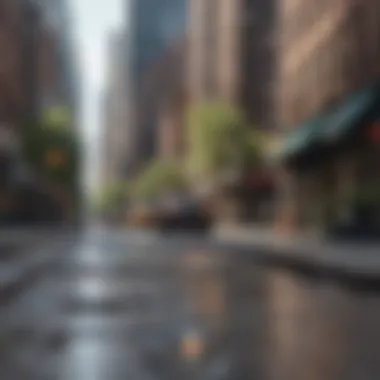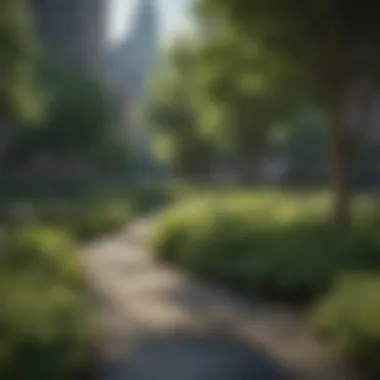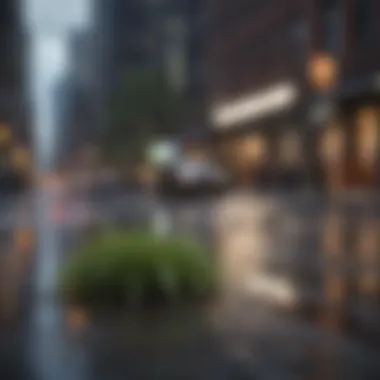Unveiling the Crucial Role of Landscape Architects in New York City's Urban Fabric


Overview of the Topic
In delving into the role of a landscape architect in New York City, it is essential to understand the intricate relationship between urban environments and green spaces. As one of the most densely populated cities globally, New York faces unique challenges in balancing sustainable green areas with urban development. Landscape architects play a pivotal role in shaping the city's landscape, emphasizing the need for thoughtful design to enhance both aesthetics and functionality.
Current Status and Challenges
The current landscape in New York City presents a complex scenario for landscape architects. Rapid urbanization and infrastructure expansion have encroached upon natural areas, leading to a decrease in green spaces. This poses a significant challenge to architects seeking to incorporate sustainable elements into the cityscape while preserving biodiversity and ecosystem resilience. Additionally, issues such as pollution, climate change, and population growth further compound the challenges faced by landscape architects in New York.
Sustainable Solutions
To address these pressing challenges, landscape architects are actively exploring sustainable solutions that merge urban development with environmental conservation. Implementing green infrastructure, such as green roofs, permeable paving, and urban forests, has emerged as a viable approach to enhance the city's resilience to climate change while promoting biodiversity. By incorporating sustainable practices into urban design, landscape architects can create functional and aesthetically pleasing spaces that benefit both the community and the environment.
Impact and Importance
The impact of landscape architecture extends beyond aesthetic appeal, influencing ecosystems, communities, and future generations. Through their work, landscape architects contribute to the ecological health of urban areas, mitigating the urban heat island effect, improving air quality, and enhancing residents' well-being. Moreover, conservation efforts and sustainable resource management practices underscore the importance of landscape architecture in promoting ecological balance and fostering a harmonious relationship between nature and the built environment in New York City.
Introduction
In the bustling city of New York, landscape architecture plays a pivotal role in shaping urban environments. It is a dynamic field that melds art, science, and sustainability to create harmonious outdoor spaces. This article aims to delve deep into the multifaceted world of landscape architecture, exploring its significance in enhancing the quality of life in urban settings while tackling complex challenges.
Understanding the Essence of Landscape Architecture
Defining Landscape Architecture
Landscape architecture is the art of designing outdoor areas to achieve aesthetic, environmental, and social outcomes. It involves meticulous planning to harmonize natural elements with built structures. The core characteristic of landscape architecture lies in its ability to blend creativity with functionality, ensuring that spaces are not only visually appealing but also practical and ecologically sound. This holistic approach enables landscape architects to create sustainable environments that benefit both humans and ecosystems.
Historical Evolution
The historical evolution of landscape architecture traces back centuries, evolving from formal gardens to expansive parks and urban green spaces. This progression highlights a shift towards more inclusive and sustainable design practices over time. By studying the historical context of landscape architecture, professionals can gain valuable insights into traditional techniques and adapt them to contemporary challenges. Understanding this evolution provides a framework for innovation and informs today's design decisions.
Importance of Landscape Architects in Urban Settings


Enhancing Aesthetics
One of the key roles of landscape architects in urban settings is enhancing aesthetics. By integrating natural elements into the urban fabric, they soften the harsh lines of infrastructure and create visually appealing environments. The strategic placement of greenery, water features, and hardscape elements adds character and beauty to otherwise mundane spaces. This aesthetic enhancement not only pleases the eye but also contributes to the overall well-being of city dwellers.
Promoting Sustainability
Another crucial aspect of landscape architects' work in urban settings is promoting sustainability. By prioritizing eco-friendly design strategies, such as the use of native plants, rainwater harvesting, and permeable surfaces, landscape architects help mitigate the environmental impact of urban development. Sustainable practices not only conserve resources but also foster resilience against climate change effects. Through innovative approaches, landscape architects play a vital role in creating greener and more livable cities.
Role of Landscape Architects in New York City
In the bustling city of New York, the role of landscape architects plays a pivotal part in shaping the urban environment. Landscape architects are essential professionals who blend artistic design with practical considerations to create sustainable and visually appealing spaces. Their expertise in studying the natural environment, understanding land use patterns, and integrating green infrastructure ensures that the city's landscapes are both functional and aesthetically pleasing. In a city known for its skyscrapers and bustling streets, landscape architects provide a vital balance by incorporating green spaces that promote environmental sustainability and enhance the overall quality of life for residents and visitors.
Creating Innovative Green Spaces
Roof Gardens:
Roof gardens are a distinctive feature in New York City's landscape architecture, offering unique solutions to limited urban space challenges. These elevated green spaces not only enhance the visual appeal of buildings but also provide environmental benefits such as improved air quality, reduction of urban heat island effect, and stormwater management. Their utilization helps combat the lack of traditional ground-level green areas, offering a sanctuary in the sky for relaxation and ecological benefits. However, the installation and maintenance of roof gardens require expertise to ensure structural integrity, proper plant selection, and irrigation systems to thrive in the city's diverse climate.
Pocket Parks:
Pocket parks, also known as mini green oases within the urban fabric, are another innovative approach landscape architects employ in New York City. These small-scale parks utilize leftover or underutilized spaces to create vibrant community gathering spots and relieve the monotony of concrete surroundings. They serve as breathing spaces in densely populated areas, fostering social interaction, promoting physical activity, and providing refuge from the urban hustle. Despite their numerous advantages, designing and maintaining pocket parks come with challenges such as land acquisition, zoning regulations, and community engagement to ensure they meet the needs of local residents while enhancing the urban landscape.
Navigating Urban Challenges
Space Constraints:
Space constraints pose a significant challenge for landscape architects in New York City, where every square foot holds value. Balancing the demand for development with the need for green spaces requires innovative design solutions that maximize land use efficiency. These constraints drive architects to think vertically, exploring opportunities on rooftops, terraces, and vertical gardens to optimize green space allocation within urban constraints. Implementing green infrastructure on limited land poses challenges in plant selection, irrigation, and structural support but contributes to sustainable urban environments.
Environmental Regulations:
Navigating environmental regulations is crucial for landscape architects operating in New York City, a city governed by stringent environmental policies. Ensuring compliance with regulations governing stormwater management, biodiversity conservation, and urban forestry is essential to creating ecologically sensitive designs. Integrating sustainable practices, such as native plantings, green roofs, and permeable pavements, not only helps meet regulatory requirements but also enhances the ecological resilience of the urban landscape.
Collaborating with Urban Planners and Architects


Integrated Development Strategies:
Collaboration with urban planners and architects is imperative for landscape architects in New York City to create integrated and sustainable development strategies. By aligning design goals with city planning objectives, landscape architects contribute to the cohesive growth of urban areas while addressing community needs and environmental concerns. Integrated development strategies encompass a holistic approach to design, considering ecological, social, and economic factors to create resilient and adaptive landscapes that enrich the urban fabric.
Design Cohesion:
Design cohesion is a fundamental element of landscape architecture, emphasizing the harmonious integration of built structures with natural elements. In New York City, where architectural diversity is prevalent, maintaining design cohesion ensures visual continuity, spatial coherence, and functional usability of public spaces. Landscape architects play a crucial role in unifying urban landscapes through thoughtful design interventions that balance form, function, and cultural significance. Achieving design cohesion requires a nuanced understanding of urban contexts, community preferences, and sustainable design principles to forge enduring connections between the built environment and nature.
Innovations and Trends in New York's Landscape Architecture
In the bustling city of New York, the landscape architecture scene is constantly evolving, with new innovations and trends shaping the urban environment. This section delves into the crucial topic of innovations and trends in New York's landscape architecture, shedding light on the forward-thinking approaches adopted by professionals in this field. Understanding these innovative practices is vital for staying at the forefront of sustainable urban design.
Sustainable Design Practices
Sustainable design practices play a pivotal role in enhancing the urban landscape while addressing environmental concerns. Within this realm, two key elements stand out: Green Roofs and Water Management Systems.
Green Roofs
Green Roofs are a distinctive feature of modern urban design, offering a host of benefits for both the city and its inhabitants. Their key characteristic lies in their ability to mitigate the urban heat island effect by providing natural insulation and cooling properties. In the context of this article, Green Roofs emerge as a popular choice due to their capacity to promote biodiversity, improve air quality, and reduce energy consumption in buildings. However, challenges such as maintenance costs and structural requirements are considerations that need to be weighed against these advantages.
Water Management Systems
Efficient water management is essential for sustainable urban development, especially in a place like New York City. Water Management Systems are integral to mitigating flooding, reducing erosion, and enhancing water quality in urban areas. Their key characteristic is the ability to collect, treat, and reuse water resources effectively. In the context of this article, Water Management Systems are a beneficial choice for their contribution to sustainable landscape architecture. However, design complexity and installation costs are factors that warrant attention when implementing these systems.
Technological Integrations
The integration of technology in landscape architecture is revolutionizing the field, offering innovative solutions to contemporary challenges. This section focuses on two significant technological integrations: Augmented Reality Applications and Drone Surveys.
Augmented Reality Applications
Augmented Reality Applications are transforming the way landscape architects visualize and communicate design ideas. Their key characteristic lies in overlaying digital information onto the physical environment, allowing for immersive design experiences. Within this article, Augmented Reality Applications are highlighted for their ability to enhance stakeholder engagement, streamline design processes, and facilitate real-time feedback. Despite their advantages, limited accessibility and technological barriers may pose challenges in their widespread adoption.


Drone Surveys
Drone Surveys are proving to be invaluable tools for landscape architects, providing aerial insights into site conditions and topographical data. Their key characteristic is the ability to capture high-resolution images and generate accurate 3D models of landscapes. In the context of this article, Drone Surveys offer benefits such as improved site analysis, cost-efficiency, and enhanced safety during surveys. Nevertheless, regulatory complexities and privacy concerns need to be carefully navigated when employing Drone Surveys in landscape architecture projects.
This section illuminates the significance of sustainable design practices and technological integrations in New York's landscape architecture, offering a comprehensive overview of the innovative trends shaping the city's urban environment.
Challenges and Opportunities for Landscape Architects in NYC
Successful landscape architecture in New York City requires a delicate balance between development and conservation. This juxtaposition between progress and preservation presents numerous challenges and opportunities. Preservation vs. urbanization stands at the forefront of this discussion. The ongoing debate between conserving historical sites and embracing modern urban expansion is crucial. While preservation safeguards cultural heritage, urbanization drives economic growth. Evaluating Preservation vs. Urbanization involves weighing historical significance against future development needs, exploring ways to harmonize the old with the new. On the other hand, Ecological Restoration plays a vital role in sustaining urban biodiversity. Implementing Ecological Restoration techniques promotes ecosystem health within the cityscape. This aspect involves revitalizing degraded landscapes, mitigating environmental impacts, and enhancing urban resilience through nature-based solutions. The unique feature of Ecological Restoration lies in its ability to rejuvenate urban ecosystems, making cities more sustainable in the face of climate change and rapid urbanization.
Balancing Development and Conservation
Preservation vs. Urbanization
Preservation vs. Urbanization embodies the dichotomy between safeguarding heritage sites and embracing urban expansion in New York City. Preservation emphasizes the cultural and historical value of existing structures, advocating for their conservation. On the contrary, Urbanization prioritizes economic growth and infrastructural development, aiming to propel the city forward. The choice between Preservation vs. Urbanization is a critical one, dictating the city's architectural landscape and cultural identity. While Preservation maintains a connection to the past and ensures historical continuity, Urbanization drives progress and innovation, shaping the city's future. In this article, understanding the nuances of Preservation vs. Urbanization is pivotal to grasping the complexities of landscape architecture in NYC.
Ecological Restoration
Ecological Restoration focuses on reviving and enhancing urban ecosystems to promote biodiversity and environmental sustainability in New York City. Through ecological interventions and habitat restoration, landscape architects contribute to the conservation of native species, restoration of natural habitats, and mitigation of environmental degradation. Ecological Restoration stands as a cornerstone in achieving urban resilience by integrating nature-based solutions into urban design and planning. The distinctive feature of Ecological Restoration lies in its capacity to foster ecological balance and create harmonious environments that benefit both wildlife and city residents.
Community Engagement and Advocacy
Public Consultation Processes
Engaging the community through Public Consultation Processes is indispensable for landscape architects in NYC. These processes involve soliciting feedback from residents, stakeholders, and experts to ensure that urban projects align with community needs and values. By incorporating public input into design decisions, landscape architects can create spaces that resonate with the local community and enhance social cohesion. The key characteristic of Public Consultation Processes is their participatory nature, fostering inclusivity and transparency in urban development initiatives. While advantageous in promoting community involvement and empowerment, Public Consultation Processes may encounter challenges related to diverging perspectives and conflicting interests.
Environmental Justice
Environmental Justice underscores the importance of fair and equitable distribution of environmental benefits and burdens in New York City. This principle advocates for the protection of marginalized communities from environmental hazards and the provision of equal access to green spaces and sustainable resources. By addressing environmental inequalities and promoting environmental stewardship, landscape architects play a pivotal role in advancing Environmental Justice. The unique feature of Environmental Justice lies in its focus on social justice, advocating for the rights of all residents to a healthy and sustainable urban environment. While offering benefits such as enhanced community well-being and environmental quality, Environmental Justice initiatives may face challenges in achieving consensus and overcoming systemic disparities.
Conclusion
In the bustling landscape of New York City, the role of landscape architects becomes quintessential. As the concrete jungle expands, finding harmony between urban development and environmental preservation is a critical concern. Through the lens of a landscape architect, understanding the significance of green spaces goes beyond aesthetics; it embodies the essence of sustainable urban living.
Considering the complexities of urban design, landscape architects play a pivotal role in reshaping the city's physical and ecological landscape. By balancing the demands of development with the need for conservation, these professionals act as stewards of the city's environmental well-being. Their expertise in designing innovative green spaces like roof gardens and pocket parks contributes not only to the visual appeal of the cityscape but also promotes biodiversity and ecological balance.
One cannot overlook the challenges faced by landscape architects in navigating urban constraints and environmental regulations. In a city where space is a premium commodity, finding ways to integrate greenery and sustainable elements requires creative solutions and strategic planning. Collaborating with urban planners and architects, landscape architects forge integrated development strategies that aim for design cohesion and functional sustainability.
As the city continues to evolve, the future of landscape architecture in New York City holds a promise of exciting innovations and sustainable trends. Embracing sustainable design practices such as green roofs and water management systems, landscape architects pave the way for a greener and more resilient urban environment. With the integration of technological advancements such as augmented reality applications and drone surveys, the field of landscape architecture is at the forefront of modern urban planning.



